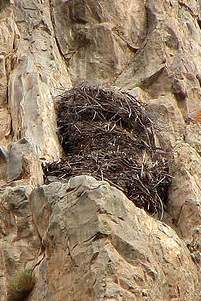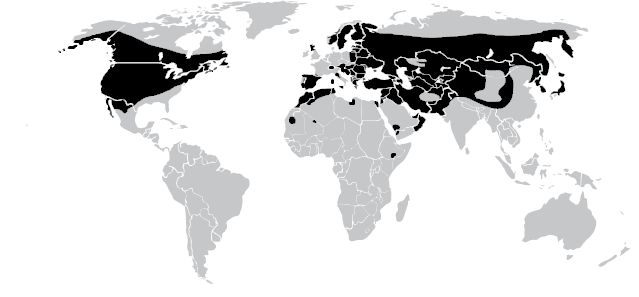Golden Eagle
Aquila chrysaetos
- Habitat: Grasslands and forests
- Range: Northern hemisphere, Europe, North Africa, Asia
- Natural Diet: Small to medium sized mammals
- Status in the Wild: Common
All about the Golden Eagle
Golden Eagles are birds of prey and are closely related to hawks, vultures, falcons, and kites. Their plumage is mostly dark brown with creamish white wings and tails tipped with black light brown and creamish white legs. Their heads and the sides and napes of their necks and nape are golden brown giving them their name. Golden Eagles have white featherless eye patches, black bills, yellow ceres, and feet. Their well-developed talons and hooked bills help them hunt and tear their meat to more effectively. Since they have a large range distribution, their plumage can vary due to different color morphs.
Although males and females are similar in color, shape, and form, females are considerably larger than males. They are active by day (diurnal) and have highly developed senses of hearing and sight that help them hunt their prey. They are large birds between three and a half feet in body length and a wingspan between six and eight feet. While females can weigh up to seven pounds, males weigh less and are about 5.5 pounds.
Diet/ Habitat/ Range
Golden Eagles have a very wide distributional range spanning North America (Canada, USA, and Mexico), Europe (Norway, Finland, Sweden, Estonia, Lithuania, Belarus, Russia, Ukraine, Poland, Slovakia, Hungary, Austria, Switzerland, Italy, Spain, Portugal, France, United Kingdom, Slovenia, Croatia, Bosnia, Herzegovina, Montenegro, Albania, Greece, North Macedonia, Bulgaria, Serbia, Romania,), Asia (Turkey, Iran, Iraq, Jordan, Israel, Saudi Arabia, Oman, Azerbaijan, Turkmenistan, Afghanistan, Tajikistan, Uzbekistan, Kyrgyzstan, Pakistan, Kashmir, India, Nepal, Bhutan, China, Myanmar, North Korea, South Korea, Japan), and northern Africa (Tunisia, Morocco, Mauritania, Mali, Niger, Ethiopia). They are habitat generalists living in varied ecosystems that include grasslands, deserts, rocky regions, shrublands, and forested habitats.
These eagles are carnivorous and mainly feed on mammals, birds, and reptiles.
Behavior
Golden Eagles that live in Finland and in the northern areas of Russia migrate south during the winter months. However, wild populations living in the southern portion of their distributional range either migrate short distances or do not migrate.
These eagles are not as vocal as other birds of prey. The only vocalizations that have been recorded are contact calls emitted by parents to their offspring. On occasion, males have been recorded emitting loud shrieks at their competitors when they are protecting their territories.
Golden Eagles are highly territorial defending their territories to protect their food resources and their families. Females are more territorial around the nesting areas, protecting their nests and chicks. They exhibit several aerial displays including steep dives and up-and-down flight movements. Aggressive posturing has also been documented where the dominant bird holds its head and neck high, ruffling its feathers to look larger than usual. Submissive birds hold their head down low and have their feathers smooth and unruffled. These are aggressive behaviors displayed while protecting their territories.
Reproduction
Golden Eagles pair with a single partner for most of their lives only changing partners if they lose their mates. Breeding is initiated through a sequence of courtship displays that include diving, soaring and circling together, chasing each other, and preening each other. Their breeding season varies across their distributional range but they breed during the spring and summer months depending on the location of their habitat).
During the breeding season, both males and females rebuild their nests with new nesting material that includes bark, twigs, sticks, grasses, and leaves, often reusing old nests. Thus breeding pairs may have access to several nests within their territories. Golden Eagles often build nests on cliffs and rocky outcrops, trees, and on man-made structures in urban environments. Some of these nests can get very large and measure up to nine feet wide and 10 feet tall.
Females can lay from one to four eggs in a clutch. The eggs are incubated for a month before they hatch. Although both males and females practice biparental care and take turns incubating eggs and feeding their chicks, females do it more predominantly. Males feed their partners and chicks when females are incubating eggs and chicks. The chicks fledge when they are about 2.5 months old and are able to fly. They start feeding themselves at about four months and reach sexual maturity between four and seven years of age.
Conservation/Status
Since free-ranging populations of Golden Eagles are estimated to be currently stable, they have been categorized as Least Concern by the International Union for World Conservation. Golden Eagles are also protected by the U.S. Migratory Bird Act.





